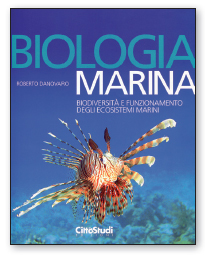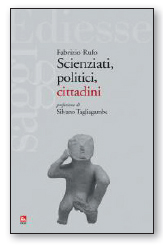BOOK REVIEWS, NOTES AND COMMENTS

Edited by Federica Napolitani Cheyne
BIOLOGIA MARINA. Biodiversità e funzionamento degli ecosistemi marini.
Roberto Danovaro. Novara: CittàStudi. Edizioni; 2013. 451 p. ISBN: 978-88-251-7369-7. € 47.00.
Oceans and seas control and regulate the climate of the Earth, while hosting an enormous and largely unexplored pool of biodiversity, also with potential for contributing to food, energy, human health, and economy and industry. In addition to the obvious fishery resources, we refer e.g. to aquaand mariculture activities, exploded in the last decades, as well as to marine biotechnology. It is therefore astonishing to realise that approximately 80% of all marine life remains unexplored and it is at the same time worrying to know that marine pollution is directly affecting human health and most fish stocks are overharvested. Therefore, the necessary knowledge to implement a sustainable exploitation and conservation of marine resources is fundamental. In this framework, the need of a university textbook on marine biology was evident in the Italian academy. The last generations of students had to rely, in addition to foreign books, to the volume of G. Cognetti and M. Sarà, conceived in 1981 with further updates [1].
Meanwhile, marine biology has substantially changed, from a sub discipline for few practitioners and passionate biologists affiliated to scattered institutions, to a real macro area now being connected in Europe into a centralised organization called EMBRC (European Marine Biology Resource Centre), which is going to become the major provider of marine biological research infrastructure and services by gathering the up-to-now fragmented institutions dedicated to coasts, seas and oceans. It has to be underlined that such EU infrastructure is a biomedical one. The challenge in fact is to eventually exploit this magnificent possibility, the above-mentioned sea and ocean biodiversity, to discover novel drugs, or even drug classes, or any other resource for the biomedical market.
The author is full professor of ecology and marine biology at the Polytechnic University of Marche (Ancona, Italy). Beside an exceptional scientific production, he is involved in many international projects and has received prestigious prizes and awards, among which the best marine biology prize Médaille d'or of the Oceanographic Institute of Paris (2010) and the World Biology Award 2010 BioMedCentral for the discovery of sediment dwelling microscopic organisms (Loricifera) that live entirely without oxygen [2]. Danovaro recently became President of the Anton Dohrn Zoological Station of Naples, a centre of excellence in marine science that was endorsed by Charles Darwin himself.
The volume is organised in two parts. The first one includes eight chapters (1-8) dedicated to the fundamentals, serving as a robust introduction to marine biology: chemical and physical features of the marine environments are described; the astonishing variety of morphological, physiological and behavioural adaptations and specializations to the wide range of conditions characterising the oceans; phylogeography and biodiversity from plankton to nekton, from viruses to whales, including the unique and largest bio constructions in the Earth; interactions among the living components, both inter- and intra-specific. The approach is holistic, always from genotype to phenotype and back. The second part (chapters 9-13) goes literally from the beach into depth, being in our view the most appealing and indeed fascinating: it explores the world marine habitats with an ecological approach, from the coastal areas, to the tropical reefs and the abyssal world, from the cold oceans to volcanoes, including submarine canyons and mountains, describing the functioning and functionality of the biological communities of these ecosystems. Chapter 12 is a matter for extremophile biologists, dealing with hydrothermal vents, cold seeps, whale carcasses and hypoxic/anoxic zones. Chapter 13 is dedicated to the two polar ecosystems, Arctic and Antarctic, with a stimulating comparative approach among them. The last chapter provides a historical and contemporary overview of marine biology in the world and in Italy, also serving as a vademecum for the orientation of young students uncertain of where to carry out their master or PhD thesis.
A particular attention is given to the methodologies, e.g. for measuring temperature, light intensity, salinity, genetic and molecular biodiversity, pollution, animal movements and so on, thoroughly described in specific textboxes and illustrations. The book does not only teach how to classify both animal and plant organisms and populations, but especially how to understand their life histories and the environmental background regulating their demographic and reproductive dynamics in space and time. A peculiar feature of the style lies in its somehow "ethological" approach. It makes the reader feel, watch and understand marine life with the senses and needs of its organisms, in other words from how they perceive and exploit their habitat.
To our knowledge, this book constitutes the most upto-date and complete text of marine biology available in Italian, and an English version is highly desirable given the wishfully increasing student exchange programmes of our academic institutions (Erasmus and Leonardo programmes). It is primarily intended for undergraduate bachelor and master students with whom the author has experienced more than twenty years of classes and practicums. The rich web support of slides and pictures will constitute an invaluable tool for teachers and lecturers. Given the potential resources and benefits of marine life for biomedicine, we recommend it also to practitioners of these fields. At the same time the book will be certainly welcome to all people operating in close contact with the sea, especially fishery and marine conservation managers, but also fishermen themselves, dive masters, and guides willing to explore marine life from the perspective of its inhabitants that means, with a scientifically neat and rigorous methodological approach.
References
1. Cognetti G, Sarà M, Magazzù G. Biologia Marina. Bologna: Calderoni; 1999.
2. Danovaro R, Dell'Anno A, Pusceddu A, Gambi C, Heiner I, Kristensen RM. The first metazoa living in permanently anoxic conditions. BMC Biology 2010;8:30.
Claudio Carere
Università della Tuscia, Viterbo, Italy
claudiocarere@unitus.it
Enrico Alleva
Istituto Superiore di Sanità, Rome, Italy
alleva@iss.it

SCIENZIATI, POLITICI, CITTADINI
Fabrizio Rufo Prefazione di Silvano Tagliagambe Roma: Ediesse Edizioni; 2014. 169 p. ISBN 978-88-230-1748-1.
Contemporary philosophy of science, as well as the different philosophical and epistemological analysis of the life sciences as different disciplinary fields, are characterized we could say by many kinds of "inattention", first of all a deep blindness toward the historical dimension of the relationship between science and society. This can be the effect of new Weltanschauungen only "present-centered" (cfr. F. Hartog, Régimes d'historicité: présentisme et expérience du temps, Paris, Seuil, 2002), or rather the heritage of Analytic tradition in its meeting Continental theoretical tradition; in any case, today the problem is that philosophical reflexion on the life sciences remains in the boundary of an abstract, purely theoretical, debate detached from reality.
We should always remember, instead, that life sciences in their historical development produce a continuous deep changing in the ideas that human beings have about themselves as active and dynamical parts/elements of society. Looking at science and its progress from a "atemporal" point of view not considering its historical and social connotation, as well as its political and economical repercussions make it impossible to get a real insight into the many connections between science, philosophy and politics. Not considering the historical dimension of science we risk to accept it uncritically, with a dangerous silence about the many topics on which science and philosophy have to dialogue: on ethical ground, for example. Ethic has a deep impact on our every day life, even if we avoid to recognise it.
I think that Fabrizio Rufo's brief pamphlet Scienziati, politici, cittadini (2014) has among its merits the clear intention to point at contemporary cultural and political problems in the relationship between science and society looking at them through a historico-critical lens. The topic is perfectly in line with the Preface by Silvano Tagliabambe: in his words "knowledge as a distributed process subsumes its environment, its culture" (p. 12). This requires a constant public engagement with science and its history.
Rufo offers a "remedy" to the diffuse chronic blindness of philosophy toward history, just looking at different "scientific revolutions" which shaped Occidental culture and civilization. And in so-doing he outlines a critical image of the present.
Assuming Darwin's evolutionary theory as the foundation of a critical analysis of scientific knowledge in its development, he opposes different "styles of thought" in philosophy and history of science, and presents many ideas and interpretative categories adopted to understand life: the interplay between chance and necessity, for instance, or cloning and research on stem cells.
The pamphlet is structured in five sections: Revolutions, Bioethics, Neurosciences, Biopolitics and Knowledge. And every section merges past and present pointing at the necessity of a collective taking on responsibility toward the progress of medicine and biology.
Referring to the great development of neurosciences in the last decades, Rufo traces back to Darwin's thought ideas on the mind-brain relationships which during the time have assumed a clear foundation in the embodied and situated dimension of cognition and behaviour. In the same way, he recognises in Darwin's The Expression of Emotions in Man and Animals (1872) the first deepimpact attribution of a adaptive and cognitive value to the emotions. And both the topics embodied and situated mind, and the essential link of reason/intellect with emotions are analysed and followed in their historical development up to the most recent scientific acquisitions. Last, but not least in importance, Rufo takes a part in the current debate on the new disciplinary identity that medicine as a science is assuming day by day in rethinking the hyper-specialisation that has penalised during the centuries the image of the physician, his scientific cultural and professional formation, and his relation with the patient.
In reflecting on the current organization of scientific knowledge, Scienziati, politici, cittadini has the great merit to deal with the most critical bioethical questions in a perspective of clear continuity with the macroand micro-politics of Italian and European sanitary guidelines. In conclusion, to my opinion a strict link between philosophical, biopolitical and sociological themes, and the constant attention to the historical dimension of scientific knowledge in the life sciences, are the most characteristic traits of Rufo's argumentation. And they are at the basis of the interest and the pleasure we feel in reading the book.
Carmela Morabito
Università degli Studi di Roma Tor Vergata, Rome, Italy
carmela.morabito@uniroma2.it
